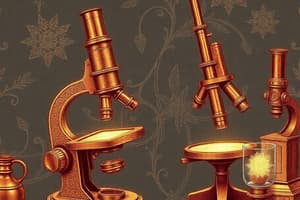Podcast
Questions and Answers
What is the primary function of a microscope?
What is the primary function of a microscope?
- To enhance the color of specimens.
- To view objects that are too small to be seen by the naked eye. (correct)
- To measure temperature changes in materials.
- To analyze the chemical composition of materials.
Which type of microscope would you use to obtain high-resolution images of a specimen's internal structures?
Which type of microscope would you use to obtain high-resolution images of a specimen's internal structures?
- Brightfield Microscope
- Scanning Electron Microscope (SEM)
- Transmission Electron Microscope (TEM) (correct)
- Phase Contrast Microscope
What is a significant benefit of using a fluorescence microscope?
What is a significant benefit of using a fluorescence microscope?
- It allows visualization of specific components within cells. (correct)
- It can magnify objects without staining.
- It does not require a light source.
- It provides 3D images of surfaces.
Which component of a microscope is responsible for further magnifying the image after it passes through the objective lenses?
Which component of a microscope is responsible for further magnifying the image after it passes through the objective lenses?
How does contrast in microscopy enhance the viewing experience?
How does contrast in microscopy enhance the viewing experience?
Which of the following statements about optical microscopes is accurate?
Which of the following statements about optical microscopes is accurate?
What is a common application of microscopy in clinical diagnostics?
What is a common application of microscopy in clinical diagnostics?
What maintenance practice should be performed to ensure the accuracy of a microscope?
What maintenance practice should be performed to ensure the accuracy of a microscope?
Flashcards are hidden until you start studying
Study Notes
Definition
- A microscope is an instrument used to view objects that are too small to be seen by the naked eye.
Types of Microscopes
-
Optical (Light) Microscope
- Uses visible light and lenses to magnify images.
- Common types:
- Brightfield Microscope: Standard, observes stained or naturally colored samples.
- Darkfield Microscope: Enhances contrast in unstained samples.
- Phase Contrast Microscope: Converts variations in light phase into contrast.
-
Electron Microscope
- Uses beams of electrons for higher resolution.
- Types:
- Transmission Electron Microscope (TEM): Electrons pass through a specimen for detailed internal structures.
- Scanning Electron Microscope (SEM): Electrons reflect off surfaces, providing 3D images.
-
Fluorescence Microscope
- Uses fluorescently labeled samples and ultraviolet light.
- Allows visualization of specific components within cells.
-
Confocal Microscope
- Uses laser beams and confocal optics to achieve high-resolution images at various depths.
-
Scanning Probe Microscope (SPM)
- Includes techniques like Atomic Force Microscopy (AFM) to study surface properties at the atomic level.
Key Components
- Objective Lenses: Magnify the specimen; different magnifications available.
- Eyepiece (Ocular Lens): Further magnifies the image for viewing.
- Stage: Holds the specimen in place.
- Illuminator: Light source; necessary for optical microscopes.
- Condenser: Focuses light onto the specimen.
Functionality
- Magnification: The process of enlarging the appearance of an object.
- Resolution: The ability to distinguish two close points; higher resolution provides clearer images.
- Contrast: Differentiating structures or components within the specimen.
Applications
- Biological Research: Studying cells, tissues, and microorganisms.
- Material Science: Analyzing materials at a microscopic level.
- Clinical Diagnostics: Examining blood, tissues, and other samples.
- Nanotechnology: Characterizing nanoscale materials.
Maintenance and Care
- Keep lenses clean and free of dust or oil.
- Properly store microscopes after use to avoid damage.
- Regular calibration is necessary for accuracy.
Limitations
- Optical microscopes have limited resolution compared to electron microscopes.
- Some specimens may require specific preparation (e.g., staining) for better visualization.
- Electron microscopes require vacuum environments and can only image non-living samples.
Microscope Definition
- An instrument used to view objects too small for the naked eye.
Microscope Types
- Optical (Light) Microscopes: Use visible light and lenses for magnification.
- Brightfield Microscope: Standard type; observes stained or naturally colored samples.
- Darkfield Microscope: Enhances contrast in unstained specimens.
- Phase Contrast Microscope: Transforms variations in light phase into contrast.
- Electron Microscopes: Employ beams of electrons for higher resolution.
- Transmission Electron Microscope (TEM): Electrons pass through a specimen for detailed internal structures.
- Scanning Electron Microscope (SEM): Electrons reflect off surfaces, producing 3D images.
- Fluorescence Microscope: Utilizes fluorescently labeled samples and ultraviolet light for visualization of specific cellular components.
- Confocal Microscope: Combines laser beams and confocal optics for high-resolution images at diverse depths.
- Scanning Probe Microscope (SPM): Includes techniques like Atomic Force Microscopy (AFM) for studying surface properties at an atomic scale.
Key Microscope Components
- Objective Lenses: Magnify the specimen; available in different magnifications.
- Eyepiece (Ocular Lens): Further magnifies the image for viewing.
- Stage: Holds the specimen securely in place.
- Illuminator: Light source; crucial for optical microscopes.
- Condenser: Focuses light onto the specimen.
Microscope Functionality
- Magnification: The process of enlarging the appearance of an object.
- Resolution: The ability to distinguish two closely spaced points; higher resolution provides clearer images.
- Contrast: Differentiating structures or components within the specimen.
Microscope Applications
- Biological Research: Studying cells, tissues, microorganisms.
- Material Science: Analyzing materials at a microscopic level.
- Clinical Diagnostics: Examining blood, tissues, and other samples.
- Nanotechnology: Characterizing nanoscale materials.
Microscope Maintenance and Care
- Keep lenses clean and free of dust or oil.
- Store microscopes correctly after use to prevent damage.
- Regular calibration ensures accuracy.
Microscope Limitations
- Optical microscopes have limited resolution compared to electron microscopes.
- Some specimens necessitate special preparation (e.g., staining) for enhanced visualization.
- Electron microscopes require vacuum environments and can only image non-living specimens.
Studying That Suits You
Use AI to generate personalized quizzes and flashcards to suit your learning preferences.




